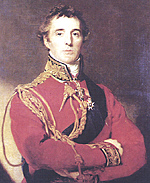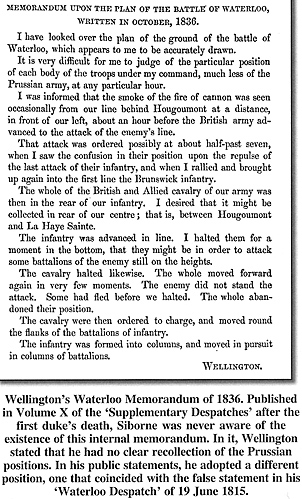Peer Pressure
Wellington, Siborne, and the Waterloo
Wellington's Waterloo Despatch
by Peter Hofschroer, Austria
| |
Before going any further, let us consider part of Wellington’s “Waterloo Despatch” written on 19 June 1815. When describing the situation at the time on which Siborne
based his Model, Wellington had written, ‘These attacks [the cavalry attacks
on his centre] were repeated till about seven in the evening, when the enemy
made a desperate effort with cavalry and infantry, supported by the fire of
artillery, to force our left centre, near the farm of La Haye Sainte, which,
after a severe contest, was defeated; and having observed that the troops
retired from this attack in great confusion, and that the march of
General Bülow’s corps, by Frischermont, upon Plancenois and La Belle
Alliance, had begun to take effect...’ [8]
According to Wellington, the sequence of events was first that the
great cavalry attacks on his centre continued until about 7 p.m., second
came the final attack led by the Imperial Guard. Wellington drove that
off and only third at that point did the Prussian intervention begin to take
effect. As this is Wellington’s first mention of the Prussian role in the
battle in the Despatch, the reader is left with the impression that there was
no noticeable Prussian involvement in the battle until then. As he made this
statement only hours after the battle, it is clear that the Duke was deliberately
playing down the role of the Prussian army in the battle at its crucial point.
After two years of exhaustive research, Siborne had become aware that
Wellington’s Despatch was fundamentally flawed. In his Memorandum on
Siborne’s Plan, the Duke praised its accuracy and commented he was
unable to be certain of the positions of the Prussians. [9]
However, since then it had evidently come to Wellington’s attention that the Plan conflicted with the Despatch and reduced the significance of his own role in the battle. Siborne was making a model that would draw public attention to his misleading statement about the role of the Prussians in the battle in the most graphic way.
Siborne declined the invitation for an interview with Wellington because a lack
of funds made it impossible for him to travel from Dublin to London. However,
he did suggest that this issue could be discussed by correspondence.
He replied, ‘I am most ready to supply answers to any questions respecting
the proposed disposition of the Troops on the Model. With respect to the
Prussians, I may observe en passant that the distribution of their 4th & 2nd
Corps coincides generally with the best French accounts & that the
disposal of the 1st Corps (Ziethen), more especially as regards the most
advanced Prussian Cavalry Regts. in [the] rear of the British left wing,
before the general advance of our line is strongly confirmed by corroborating
evidence in my possession.’ [10]
Siborne had done his research and was sure of his facts. His correspondence
shows that he continued to address the issue of the Prussian involvement in the battle. He discussed this in detail with Vivian, whose cavalry brigade at Waterloo had moved from the left to the centre of Wellington’s positions before that attack of the Imperial Guard and had only been able to do so because the Prussians had relieved him. Vivian not only confirmed that Siborne was
correct, but also that Wellington knew so, because he had issued the order for
this move. Siborne then took the matter up with FitzRoy Somerset again.
In February 1837, Siborne asked FitzRoy Somerset a second time to see
that the government granted him the cost of the construction of the Model, and if
not, that Lord Hill and FitzRoy Somerset would make good an earlier promise to
contribute to his costs. However, historical truth was not the issue, rather
Wellington’s image.
As FitzRoy pointed out in his reply, those ‘who see the work will deduce from it that the result of the Battle was not so much owing to British Valour, and the great Generalship of the Chief of the English Army, as to the flank movements of the Prussians’. [11]
FitzRoy Somerset declined to subscribe to the Model.
This fruitless exchange continued throughout the spring of 1837. Vivian
supported Siborne’s view, confirming that Wellington must have been very
much aware of the effects of the Prussian intervention before mentioned
in the Despatch. ‘The Enemy,’ wrote Vivian, had ‘in consequence [of the
Prussian advance] begun to waver and send some part of their Force towards
the rear which was observed by the D of Wellington (I apprehend) before he
gave the order to move.’
Vivian continued sarcastically, ‘I know not
what high authority may object to giving due credit to the Prussians -
certainly not the D of W. I should think.’ [12]
On 28 August, FitzRoy Somerset rebuffed Siborne with a curt answer, concluding the matter for the time being, at least. [13]
Peer Pressure Wellington, Siborne, and the Waterloo
|

 Lord Wellington
Lord Wellington
 Wellington’s Waterloo Memorandum of 1836. Published in Volume X of the ‘Supplementary Despatches’ after the first duke’s death, Siborne was never aware of the existence of this internal memorandum. In it, Wellington stated that he had no clear recollection of the Prussian positions. In his public statements, he adopted a different position, one that coincided with the false statement in his ‘Waterloo Despatch’ of 19 June 1815.
Wellington’s Waterloo Memorandum of 1836. Published in Volume X of the ‘Supplementary Despatches’ after the first duke’s death, Siborne was never aware of the existence of this internal memorandum. In it, Wellington stated that he had no clear recollection of the Prussian positions. In his public statements, he adopted a different position, one that coincided with the false statement in his ‘Waterloo Despatch’ of 19 June 1815.